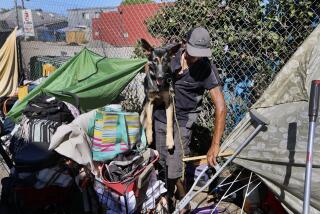Skid Row Camps: It Got Warm, but They’re Still Here
- Share via
The Skid Row encampments whose residents face arrest by Los Angeles police later this week historically have been a winter phenomenon. But this year, as warmer weather came, the camps, instead of disbanding, are becoming bigger and more permanent.
“There are at least 13 or more locations where people sleep,” said Police Capt. Rick Batson, commanding officer of Central Division. A number of them, he added, are “entrenched and growing in size.”
While sidewalk shantytowns have been as much a part of Skid Row life as its crowded shelters and dingy bars, they usually are “cyclical,” longtime Skid Row experts say.
This time, however, “It’s a whole new ballgame,” said Alice Callaghan, director of Las Familias del Pueblo, a family day-care center on Skid Row.
“I don’t see any diminution,” said Clancy Imislund, director of the Midnight Mission.
Police Chief Daryl F. Gates, when he announced last week that those sleeping in the makeshift camps would be subject to arrest starting Thursday, said the majority of residents are there because Skid Row is “where they want to live.”
However, social service providers and other Skid Row experts say other reasons--a housing shortage, a changing homeless population and psychological factors--also account for the camps’ continued presence.
Some say the encampments are a reflection of a shrinking supply of low-cost housing in the area. “It’s a new phenomenon of less housing available, (and the) housing that is available with rates that are too high,” said John Dillon, director of Chrysalis Center, a self-help agency on Skid Row.
He said about 1,400 hotel and single-room apartments have been lost in the last year as five hotels were closed for rehabilitation, another five were scheduled for demolition and several hotels suffered fires that damaged rooms.
Others believe Skid Row has become a regional magnet for the homeless, because of the concentration of services provided there, and say the growth of the camps partially reflects this.
‘Attractive Nuisance’
“There’s thousands of free meals, a couple of thousand free beds,” said Dr. Rodger K. Farr, chief of the Medical and Psychiatric Consultation Services Division of the Los Angeles County Department of Mental Health. “You’ve created an environment . . . like a garbage can. Government agencies, private agencies are referring all these people down to Skid Row because they have these services. That’s created an attractive nuisance.”
Others contend that the camps are also a reflection of a changing population on Skid Row, which includes a younger, angrier, more predatory group.
While older populations traditionally leave in the summer to do migrant work, Imislund noted that the newer transients are “young, aggressive drug-oriented people. They don’t go anywhere. They just stay and prey on one another.”
While police and other observers believe that the camps house many of this newer group, the camp inhabitants themselves say they feel safer from predators by banding together there than living alone in local hotel rooms.
Seen as Hindrance
But Deputy Mayor Grace Davis, head of a city task force on homelessness, sees the camps as a hindrance to any permanent resolution of the problem.
“To really impact people, we’ll have to capture them out of the streets. As long as we tolerate it (the camps) we cannot really address long-term solutions,” she said. “As long as they start congregating, they become comfortable with a group and that’s their security.”
However, Farr has a different view of the sense of security the camps offer.
“There are a lot of positive aspects in developing a sort of camaraderie, some sense of belonging somewhere,” he said. “If they were not in that location, on the streets, I don’t think the phenomenon is all that bad, as long as it were hooked with somebody trying to solve the basic problem that’s making them homeless.”
‘Small Steps’
Many of the homeless themselves believe that camp life, when organized, can provide a positive way to reintegrate homeless people. Often, they say, people don’t have the discipline to follow even the county guidelines, such as monthly work projects or mandatory job searches, necessary to stay on general relief.
Rehabilitation has to start with “small steps that get larger,” said Rachel Verdugo, 38, a recovered alcoholic who lives in one of the most organized of the camps, on Towne Avenue between 4th and 5th streets. Residents there share clean-up duties and the cost of two portable toilets.
Members of this encampment, known as the “Love Camp,” have been trying to get officials to back a city-sponsored camp, which would provide a first step in rehabilitation. Verdugo claimed city officials once promised to help find a site.
“We’ve been looking for property to develop shelters,” Deputy Mayor Davis said last week. “We’re not looking for encampments as much as shelter, so we’re not just recycling people.”
The City Council today will consider two motions regarding the pending police crackdown. Councilman Zev Yaroslavsky has proposed a suspension of the sidewalk ordinance enforcement, and Councilman Ernarni Bernardi has proposed temporarily opening City Hall or other city buildings, including a now-closed emergency shelter in Little Tokyo, and an indefinite extension for a 138-bed shelter on San Pedro Street scheduled for closure at the end of June.
More to Read
Sign up for Essential California
The most important California stories and recommendations in your inbox every morning.
You may occasionally receive promotional content from the Los Angeles Times.













